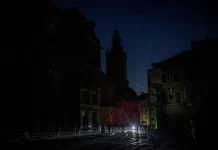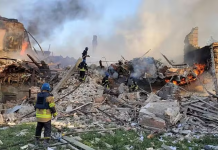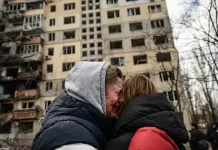Kyiv — Ukraine endured one of the most devastating nights since the beginning of Russia’s full-scale invasion, as Russian forces unleashed an unprecedented wave of missile and drone strikes targeting the nation’s energy system and civilian communities.
According to Ukraine’s Air Force, the assault involved 416 aerial weapons: 381 Shahed, Gerbera, and other attack drones, 7 Iskander-M/KN-23 ballistic missiles, 21 Iskander-K cruise missiles, and 7 Kh-59/69 air-launched missiles. Despite the destruction or suppression of 320 enemy targets—including 303 drones and 17 missiles—dozens broke through Ukraine’s defenses. At least 18 missile impacts and 78 drone strikes were confirmed across 15 locations, with falling debris recorded in six others.
The main targets of the massive overnight bombardment were energy infrastructure facilities in Kharkiv and Poltava Oblasts, resulting in widespread blackouts and crippling damage. Communities in Sumy, Dnipropetrovsk, Odesa, and Kyiv Oblasts also reported destruction to power facilities and residential areas.
- In Poltava’s Karlivka community, nearly 8,400 households were left without electricity.
- In Sumy Oblast, strikes on the Shostka community knocked out power and disrupted water supplies; hospitals are now running on backup generators.
- In Kherson Oblast, shelling killed livestock, destroyed homes, and injured civilians, including three men suffering traumatic brain injuries in Zelenivka.
Civilian casualties continue to mount. In Kherson city, a 56-year-old woman sustained blast injuries and a broken bone when artillery fire struck her yard. In Zaporizhzhia district, Russian air bombs and drones destroyed civilian property, wounding a 50-year-old woman and a 29-year-old man. In Kupyansk district, four people were injured by a drone strike.
The human toll extended beyond civilians: near Druzhkivka, Donetsk Oblast, a Russian FPV drone directly attacked a car carrying journalists. French photojournalist Antony Lallican was killed, while Kyiv Independent journalist Heorhiy Ivanchenkov was severely wounded, despite wearing protective gear and being accompanied by a press officer.
Meanwhile, Ukraine’s Main Intelligence Directorate reported a shocking atrocity in a Russian-occupied area of Kharkiv Oblast: a Russian soldier opened fire inside an apartment building, killing three civilians before dying from his own bullets.
Amid the devastation, small rays of hope emerged. The government announced that 22 Ukrainian children and teenagers were successfully returned from Russian-occupied territories as part of President Volodymyr Zelenskyy’s “Bring Kids Back UA” initiative.
The scale of the October 3 assault underscores Russia’s escalating air campaign. September already saw a 47% increase in missile attacks compared to August, with the southern front heavily targeted. The overnight strike also marked the largest attack on gas production infrastructure since the start of the full-scale war, with Naftogaz facilities in Kharkiv and Poltava Oblasts suffering significant—some critical—damage.
Since the invasion began, at least 1,330 Ukrainians have been injured by mines and explosive remnants, including 135 children, a grim reminder of the war’s enduring danger beyond the battlefield.
As winter approaches, Ukraine faces mounting challenges to protect its energy grid, communities, and people against Russia’s relentless campaign of destruction.
BY: The Times Union







